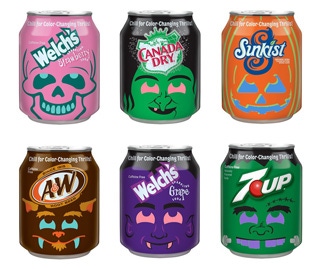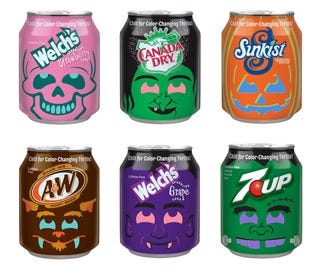Specialty inks boost brands by making packaging interactive
March 11, 2015

Interactive packaging is a proven way to capture and hold consumer attention. For primary or promotional packaging brand support, few interactive technologies are as appealing to packaging designers and brand marketers as high-performance specialty inks. They open the door to a range of creative possibilities, yet can be applied using an array of conventional package printing processes, a quality that ca
Thermochromic
n enable packaging interactivity to become a part of a brand's very identity.
First, a review of the power of interactivity. Packaging that provides more than simple brand identity, instructions and nutritional information has made remarkable inroads in the last decade or so. Interactive packaging engages with consumers in ways that better capture and hold their attention in the retail environment during those fleeting brand selection "moments of truth." The power of interactive packaging isn't limited just to on-the-spot consumer purchase decisions. Marketers have also found that interactive packaging can actually increase product consumption.
An excellent example is Coca Cola's 2001 introduction of the 6 x 2 in. Fridge Pack. The company's research had shown that a cold beverage product is 70 percent more likely to be consumed if it is cold and ready to drink, rather than warm on a pantry shelf. Compared to the prior 3 x 4 in. format, the 6 x 2 in. Fridge Pack was designed to encourage consumers to move the package directly from the car trunk to the refrigerator. Sales data confirmed the research strikingly. A year after the Fridge Pack introduction, Coca Cola measured sales gains of +3.3 percent for Coke Classic, +8.3 percent for Diet Coke and +3.2 percent for Sprite.
Another illustration is the blockbuster success of the Coors Light color-changing mountains. Sales of Coors Light rose 3 percent in the first year after adding specialty thermochromic inks to make the mountains turn blue on the surface of aluminum cans as well as bottle labels. That sales momentum continues today. In early 2012, the industry publication Beer Marketer's Insights reported that Coors Light displaced Anheuser-Busch's flagship Budweiser brand to become the No. 2 selling beer in the U.S.
Both Coke and Coors proved that the beverage package can drive significant sales gains. And the drive toward interactive packaging extends far beyond just a few key brands. It's a natural extension of the food and beverage industry's understanding that effective package designs must reach as deeply as possible into the consumer experience.
At a recent conference, PepsiCo's director of advanced research, Denise Lefebvre, spoke to this idea when she summed up four key post-purchase ideas the company strives to integrate into its consumer packaging:
• Makes their lives easier.
• Allows them to control the product experience.
• Reassures them about product freshness and purity.
• Enriches their product experience.
Simple answer with high impact
Specialty inks offer brand owners many simple and inexpensive ways to achieve impact and functionality that rivets consumer attention. Since virtually all packaging involves some kind of printing, the switch from a conventional decorative ink to one that adds compelling functionality is often simple and straightforward. This can avoid the higher expense of other interactive packaging concepts, such as producing complex 3-D packages or the supporting fulfillment architecture required in QR code promotions.
Specialty inks offer a range of interactive capabilities that can be applied to almost any packaging substrate. Some of the more exciting choices are thermochromic (changing color with temperature), photochromic (changing color on exposure to light), glow-in-the-dark inks, color-shifting pearlescent inks and tactile inks that are affected by touch.
Specialty inks energize brands
While some have been used with considerable success, a common misperception of specialty inks is that they are niche products with a limited range of potential uses. In fact, their unique and fascinating performance opens up a remarkable range of possibilities to make packaging more immediately compelling. They can also drive longer and more memorable consumer interaction with an almost unlimited range of products. Here are some ways to think about the potential of specialty inks:
Express the benefit
Specialty inks are uniquely powerful in their ability to present metaphors that create positive product association and express key product benefits. They can be used to create objects or scenes that appear during product consumption to help support or even fulfill the core brand promise. For example, a prototype foodservice cup uses thermochromic ink to instantly depict the sky and sun when a hot beverage is added. The printed message on the cup reads "When you poured coffee into this cup, it woke up. Our coffee will have the same effect on you, we promise."
Other metaphors can be achieved with specialty inks by mimicking the passage of time in daily life. A thermochromic label that changes from a daytime to a nighttime theme as a beverage is cooled can provide a powerful "night life" metaphor for alcoholic beverages.
"Throwback" concepts that help consumers recapture associations with brands from earlier in their lives are also powerful. Thermochromic, photochromic and fluorescent inks can all be used to achieve in-use transformations on packages to recall container shapes, colors, logos or typography from familiar products of yesteryear.
Enrich the brand experience
Specialty inks like thermochromics or photochromics can enhance familiar package designs to deliver specific messages at an appropriate moment without significantly altering the familiar visual identity of the brand. Brand owners can target specific groups of consumers or create a specific brand association. For example, a promotion for Monster energy drink honoring the military used thermochromic ink to reveal a graphic of a soldier when the otherwise familiar can was chilled.
This concept can be leveraged in brand promotions linked to sports, holidays or sponsored events. Interactive graphics can be applied to packaging used specifically at an event venue, or it can convey sponsorship messages in national or even international campaigns.
Similarly, specific product categories or brands have powerful emotional connections with special moments, which can be brought alive by packaging decorated with specialty inks. Graphics that evoke scenes of holidays, family events, summer travel, relationships between people, relaxation time, candlelight, firelight and party times can all be applied to packaging and activated by heat, cold, sunlight or black light.
Connect brand to its environment
Some products have strong associations with specific environments, and specialty inks offer designers many opportunities to make the connection.
Photochromic inks offer great opportunities for "outdoor brands" typically consumed under the sun in outdoor environments. When exposed to sunlight, photochromic inks transform from clear to colors that add life to products such as barbeque sauces, sports beverages, snack foods, soft drinks, beer and pre-mixed light alcoholic lemonades and coolers.
Earn quality time for your brand
Specialty inks give designers the power to embed change on their packages, which can significantly extend the time consumers interact with brand messaging. This can breathe new life into time-proven "hidden code" promotions. Thermochromic inks formulated for specific temperatures can display codes or solutions that appear at a specific time during use, so the consumer will stay involved with the package or container for an extended period of time. Beyond simply concealing text codes, this concept can be extended to more elaborate graphics that incorporate a number of thermochromic colors, all with the ability to appear or clear at different target temperatures.
Set your brand free
The power of specialty inks needn't be locked on the surface of a can or package. Two-dimensional inserts or accessories, such as stickers, coupons, or thin discs can be imprinted with specialty inks that can extend the expression of brand messages away from the original product. For example, an ordinary-looking thermochromic sticker comes to multicolored life almost immediately when placed in the freezer. Similarly, almost "instant-metamorphosis" effects can be executed with photochromic inks. The possibilities for increasing the interactivity of game pieces, trading cards or collectable graphic designs are almost unlimited. What about a nightclub poker game played with fluorescent cards attached to beverage cans or bottles? This higher-tech twist on memorable take-aways could even help a brand owner enjoy renewed success with a variation on the "Pogs" craze of the 1990s.
Make life more fun
Packaging can include fun for consumers, especially kids. Thermochromic and photochromic inks are especially well-suited to create puzzles, mazes and hidden objects that appear or disappear quickly in response to the temperature of fingers or to sunlight. The back panel of a cereal box or other flat package is an ideal venue for this kind of engaging graphic, which could even keep a squirming child happily occupied while riding in a shopping cart seat.
Create a "smarter" package
Specialty interactive inks can also take on more functional roles. One example is the color-changing "hot indicator" lid that provides an alert to a hot drink in a beverage cup; thermochromic pigments are added to the plastic resin prior to forming the lid. Thermochromic inks can also be used as temperature indicators on hot food delivery packages like pizza boxes, or as level indicators for beverage containers. Both fluorescent and thermochromic inks also have a variety of uses in overt and covert security tagging for shipping and inventory control applications.
For interactivity that boosts the selling power of packaging, specialty inks stand apart. They are unlocking opportunities for brand differentiation, consumer satisfaction and brand loyalty. They contribute new levels of excitement and engagement for a richer and more profitable brand experience.
Robert Ugianskis is vp and general manager of Chromatic Technologies Inc. For more information, visit www.ctiinks.com.
About the Author(s)
You May Also Like


